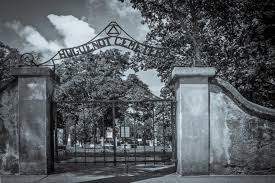St. Augustine: America’s Oldest — and Most Haunted — City
St. Augustine, Florida, isn’t just the oldest continuously occupied European-established settlement in the United States — it’s also one of its most haunted. Beneath its cobblestone streets and sunlit balconies lies a long, layered history of conquest, disease, tragedy, and legend. Founded in 1565 by the Spanish, this city has seen centuries of battle, piracy, plagues, and more than a few unexplained occurrences.
.

St. Augustine, Florida, holds the title of America’s oldest continuously inhabited European-established city, and its story begins with conquest and bloodshed. In the mid-1500s, King Philip II of Spain grew increasingly concerned about French Protestant influence in the region. To eliminate that threat and strengthen Spain’s control, he appointed Pedro Menéndez de Avilés, the Captain General of the Spanish Armada, to lead a military expedition. In May of 1565, Menéndez and his fleet set sail. They spotted land on August 28, an auspicious date that coincided with the feast day of Saint Augustine of Hippo. In reverence to the saint, a philosopher and theologian revered for his influence on early Christianity, the settlement was named St. Augustine.
The History
The city’s early days were anything but peaceful. Soon after landing, Menéndez clashed with French forces who had established a foothold nearby. Though initially on the defensive, the Spanish swiftly overpowered the French. Menéndez ordered the execution of all captured men, hanging their bodies from trees with a chilling sign that read, “Hanged not as Frenchmen, but as heretics.” A second group of 134 surrendered Frenchmen was executed weeks later, their blood said to have stained the waters red. The site of these killings became known as Matanzas Bay, Spanish for “massacre.” It earned Menéndez a nickname that would echo for centuries: The Butcher of Avilés.
St. Augustine would not be left in peace for long. In 1586, the English privateer Sir Francis Drake launched a raid during the Anglo-Spanish War with a fleet of 23 ships and nearly 2,000 men. The Spanish defenders evacuated, leaving Drake to seize artillery and a royal strongbox filled with gold. But after the Spanish rear guard killed his sergeant major, Drake retaliated by burning the settlement to the ground. The city would rise again, but it was only the beginning of a long, violent pattern.
Disease followed soon after. Beginning in 1649, St. Augustine endured a series of devastating epidemics: yellow fever, smallpox, and measles swept through the population. Then, in 1668, English pirate Robert Searle launched a surprise nighttime attack. Sailing from Jamaica, Searle’s crew slaughtered over sixty residents, looted homes, and kidnapped civilians — including children and members of the Black and Native communities — to sell into Caribbean slavery. In retaliation for Spanish attacks in the Bahamas, the raid finally convinced the Spanish Crown that more permanent defenses were needed. Construction on the stone Castillo de San Marcos began in 1672 and would eventually become the city’s iconic fortress.
St. Augustine’s darkest health crisis came in 1821 with another wave of yellow fever. This time, the disease arrived via infected ships from Havana. One-third of the population perished, making it the deadliest epidemic in the city’s history. Today, many believe the souls of the fever victims still linger in the old hospital district, wandering and unsettled.
By the late 1800s, St. Augustine’s identity began to shift. Oil tycoon Henry Flagler envisioned the city as a luxury escape for the wealthy and elite. In 1888, he opened the opulent Ponce de Leon Hotel, a marvel of architecture adorned with Tiffany glass. He later built the Hotel Alcazar and funded the Florida East Coast Railway, extending it to Key West by 1912. Flagler’s vision transformed St. Augustine into a thriving tourist destination, but its past was never far behind.
The Hauntings
One of the most infamous haunted buildings in the city stood at 7 Aviles Street. Originally built as a jail in the late 1800s atop the Los Remedios Catholic Cemetery, the structure saw many transformations, housing a Chinese laundry, shops, and, eventually, the beloved antique store known as Antiques and Uniques. Owners Larry and Denise Altman reported consistent paranormal activity, from unexplained voices to flickering lights and cold spots. A&E’s My Ghost Story featured the shop in an episode highlighting strange footage: a flashlight turning on itself, a refrigerator door swinging open without cause, and even a phantom meowing despite no cats in the store.
Before the shop’s permanent closure in 2018, paranormal investigator Ryan Dunn conducted a final investigation. During an EVP session, his team captured a chilling voice that growled, “Kill them.” The investigation also focused on two dolls, Chloe and Meredith, who were long rumored to be haunted. Another EVP captured the voice of a young girl, saying, “We hate the girl too, but I’m watching him,” suggesting the spirits were aware of the team.
Hauntings in the city gained a more gruesome context in October 2016 when Hurricane Matthew caused severe flooding downtown. While repairing water damage in a nearby wine shop, crews uncovered skeletal remains beneath the floorboards: seven people, including three children, dating back to the 1500s. Among the artifacts found was a fragment of thatch roofing believed to belong to the original Catholic church, destroyed in Drake’s 1586 raid. The proximity of these remains to known paranormal hotspots only fueled speculation that some spirits may have been unearthed… literally.
Other locations in St. Augustine have their own ghost stories. The St. Francis Inn, built in 1791, is haunted by a spirit named Lily, believed to be an enslaved girl who fell in love with the innkeeper’s relative. Accounts differ, but many say her death was tragic and unjust and that she never left. Guests in the Garcia Suite often report footsteps, cold spots, or seeing a young woman in white gazing from the window.
The Old Jail, constructed in 1891 with funding from Flagler, was closed in 1953 after decades of cruelty. Despite its Victorian exterior, its cells were filled with violence, suffering, and death. Inmates were executed on-site, and many women imprisoned there died under suspicious conditions, some for mere acts of poverty or defiance. Visitors today report disembodied voices, shadow figures, and even being pushed or scratched during ghost tours.
Then there’s the Castillo de San Marcos, the coquina fortress that withstood centuries of siege and storm. Rumors abound of two female lovers walled alive inside its chambers, their skeletons allegedly discovered centuries later behind sealed stone walls. Visitors often report smelling perfume or cigar smoke and hearing voices in Spanish echoing through the corridors. Some even claim to see the headless spirit of Seminole leader Osceola, who was imprisoned and mutilated after his death.
Perhaps the city’s most tragic and well-known haunting occurs at the St. Augustine Lighthouse. During construction in 1873, four young girls drowned in a horrific accident while playing with a supply cart. Since then, reports of childlike laughter, ghostly figures, and phantom footsteps have continued. The lighthouse has been featured on Ghost Hunters and remains one of America’s most investigated haunted sites.
Only a short walk away, the Huguenot Cemetery tells a quieter but equally chilling story. Established in 1821 to bury yellow fever victims, it’s said to be haunted by the spirit of a young girl in white named Elizabeth and the stern, vengeful ghost of Judge John Stickney, whose gold teeth were stolen during his exhumation. Though the cemetery is closed to the public, witnesses have captured apparitions and voices outside the iron gates.
St. Augustine is more than just a picturesque coastal town; it is a living monument to centuries of conflict, heartbreak, survival, and mystery. Its history is written in textbooks and whispered in old buildings, echoed in abandoned cells, and reflected in flickering lights that no one can quite explain. Whether you’re a historian, a skeptic, or a full-fledged believer, something in St. Augustine will reach out and touch you. And if you find yourself walking those ancient streets at night, listen closely. That chill you feel might not be the wind. And that sense you’re being watched? You probably are.
Resources
Dunn, R. (2014). St. Augustine’s Afterlife: True Tales of a Paranormal Investigator. Pineapple Press.
Augustinians Province of St. Thomas of Villanova. (n.d.). Feast Day of St. Augustine — August 28. Retrieved from https://augustinian.org/feast-day-of-st-augustine-august-28
HauntedPlaces.org. (n.d.). Antiques and Uniques Collectibles. Retrieved from https://www.hauntedplaces.org/item/antiques-and-uniques-collectibles/
Old Town Trolley Tours. (n.d.). St. Augustine’s Old Jail After Dark | Old Jail Paranormal Night Tour. Retrieved from https://www.trolleytours.com/st-augustine/old-jail-after-dark-tour
Haunted US. (n.d.). Castillo de San Marcos’ Long Dead Spirits Linger. Retrieved from https://hauntedus.com/florida/castillo-de-san-marcos/
GhoSt Augustine. (n.d.). The Huguenot Cemetery: St. Augustine’s Spirit Central. Retrieved from https://ghostaugustine.com/blog/the-huguenot-cemetery-st-augustines-spirit-central/
Ghosts & Gravestones. (n.d.). The Most Haunted Places in St. Augustine. Retrieved from https://www.ghostsandgravestones.com/st-augustine/haunted-places
St. Augustine Lighthouse & Maritime Museum. (2020, March 2). Ghost Stories: The Pittee Girls. Retrieved from https://www.staugustinelighthouse.org/2020/03/02/ghost-stories-the-pittee-girls/

Dive into the chilling world of horror literature and explore spine-tingling tales crafted by Samantha Almeida. Follow me on social media for the latest updates, exclusive content, and a community of fellow horror enthusiasts. Remember, the shadows are always watching—stay connected and keep the scares alive!
Home | About | Services | Privacy Policy
